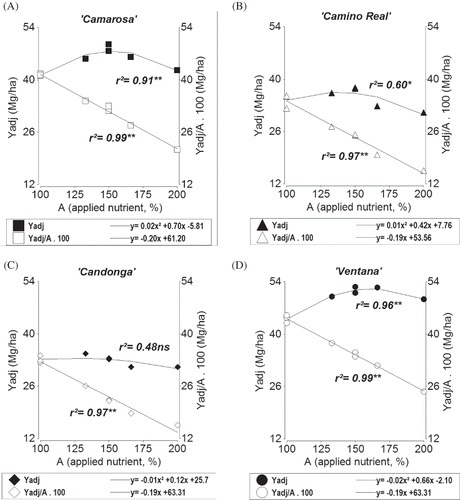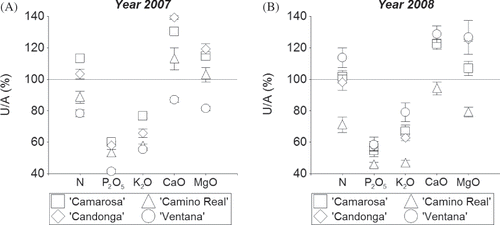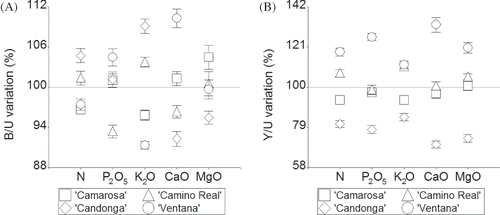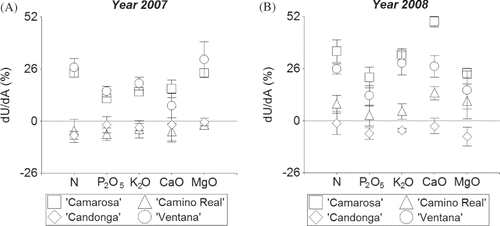Abstract
In annual strawberry (Fragaria x ananassa Duch.) production systems in Argentina, fertilizers are frequently applied without considering soil fertility, cultivar particularities, and nutrient use efficiency (NuUE). The objective of this study was to investigate the NuUE of different strawberry cultivars. In 2006, 2007, and 2008, field plots of ‘Camarosa’, ‘Camino Real’, ‘Candonga’, and ‘Ventana’ were fertilized at different nutrient rates. Control treatment (“C”) was 120 N, 70 P2O5, 220 K2O, 40 CaO, and 20 MgO (kg/ha). In 2006, treatments were “C” and “1.5C”, in 2007, “C”, “1.33C” and “1.66C”, and in 2008, “C”, “1.5C” and “2C”. Productivity from the applied-nutrients was inversely proportional to the applied-nutrient rate, and it was higher in high-yielding cultivars (‘Camarosa’ and ‘Ventana’). Optimal N dose (in kg/ha) was 183, 196, 165, and 150, for ‘Camarosa’, ‘Ventana’, ‘Camino Real’, and ‘Candonga, respectively. Apparently, NuUE is cultivar related, and might become a useful tool for adjusting fertilization programs and characterizing new cultivars in breeding programs.
INTRODUCTION
A review of nitrogen fertilization practices for strawberry (Fragaria x ananassa Duch.) in winter production regions, such as Florida, California, and southern Spain, shows a broad range of rates, from 168 to 336 kg/ha regardless of soil and genetic particularities (CitationCadahía López et al., 2005; CitationPeres et al., 2010; CitationStrand, 1994). In contrast to N, the applied rate of other macronutrients such as P, K, Ca, and Mg are adjusted according to plant and soil analyses (CitationCadahía López et al., 2005; CitationHochmuth et al., 1996; CitationKirschbaum et al., 2006; CitationPeres et al., 2010). Interestingly, studies regarding N absorption in strawberries ranged from 78 to 125 kg/ha (CitationLieten and Misotten, 1993; CitationTagliavini et al., 2005), which could be an acceptable range for plant nutrition studies since excessive fertilizer rates could cause damage to the crop, increase production costs, and contaminate the environment (CitationGiuimerà et al., 1995). Soil contamination is an issue of increasing concern because it reduces soil quality, which is a major problem in a world where population growth and urbanization are significantly reducing land availability for agricultural use (CitationBruinsma, 2003).
Nutrient use efficiency (NuUE) can be calculated with different equations, which take into account nutrient acquisition from the soil, nutrient capability to generate biomass, and nutrient remobilization to organs of agronomic interest (CitationBaligar et al., 2001). Productivity from applied nutrient (Y/A) is a partial factor that quantifies the total economic output in relation to the utilization of all the applied nutrients (CitationCassman et al., 1996):
The partial nutrient budget (U/A) is a nutrient flow index of the system used to detect nutrient depletion or accumulation (CitationBekunda and Manzi, 2003):
Nutrient recovery efficiency (dU/dA) indicates the amount of added nutrient that the plant absorbed and reflects plant ability to acquire applied nutrient from the soil (CitationBaligar et al., 2001; CitationCassman et al., 1996):
In this equation, Ua is nutrient uptake in added-fertilizer plants, Uc is nutrient uptake in control plants, Aa is applied nutrient in added-fertilizer plants, and Ac is applied nutrient in control plants.
Nutrient efficiency ratio, in terms of total plant biomass (B/U), is equivalent to the reciprocal of nutrient concentration in the whole plant and describes the plant internal nutrient requirement (CitationBaligar et al., 2001; CitationGourley et al., 1994):
The nutrient efficiency ratio, in terms of yield (Y/U), differentiates genotypes into efficient and inefficient in function, of their capability to utilize nutrients (CitationBaligar et al., 2001; CitationGourley et al., 1994):
The utilization efficiency indexes (Y/U and B/U) are numerator related:
In this equation, DWR is the fruit fresh weight:fruit dry weight ratio. We hypothesized that Y, B, B partitioning, whole plant [Nu], and response to fertilization (all related to NuUE) vary among genotypes in strawberry. In Florida, several field trials involving cultivars, such as Camarosa, Sweet Charlie, Strawberry Festival, and Winter Dawn, exposed to different N rates demonstrated genotype-related responses to N (CitationSantos and Whidden, 2007; CitationSimonne et al., 2001, as suggested by CitationTagliavini et al., 2005), in studies conducted on the cultivars, Idea and Marmolada, in Italy. In Portugal, differences between [K], [Mg], [Ca], [Cu], [Zn], and [Mn] were found among ‘Ventana’, ‘Camarosa’, and ‘Candonga’ (CitationPalencia et al., 2010).
Under the described referential frame, the objective of this study was to investigate plant nutrient use efficiency (NuUE) of different field grown strawberry genotypes.
MATERIALS AND METHODS
The experiments were conducted on a silt loam soil (pH = 5.9; EC = 0.6 mS/cm), during three annual production cycles (2006, 2007, and 2008) at INTA's Estacion Experimental Agropecuaria Famailla (27° 03′ S, 65° 25′ W, 363 m elevation) in Tucuman, Argentina. Cropping beds consisted of raised beds 1.25 m apart, 0.40 m high, 0.50 m wide, covered with black polyethylene mulch, with two rows of plants (50,000 plants/ha). A rate of 200 kg/ha of 15-15-15 fertilizer was applied as pre-plant fertilizer every year. In all three years, fresh-dug bare-root transplants from high-latitude nurseries (42° S) were planted the week of 26 Apr.–3 May.
Strawberry cultivars evaluated in this study were Camarosa (intermediate harvest date), Camino Real (late harvest date with a compact plant), Candonga (late harvest date with a vigorous plant), and Ventana (early). In all three years, a control fertilizer (treatments C) consisted of 120 kg ha, 70 kg P2O5 ha, 220 kg K2O ha, 40 kg CaO ha, and 20 kg MgO ha. Rates applied consisted of C and 1.5C in 2006; C, 1.33C and 1.66C in 2007; and C, 1.5C and 2C in 2008. All fertilization treatments had the same nutrient ratio: N:P2O5:K2O:CaO:MgO = 1:0.6:1.9:0.4:0.2. The control treatment represents a moderate, balanced nutrient application that takes into account recommended practices, published studies, and adjustments according to soil and water analyses after planting. Fertilizers used were urea, potassium nitrate, calcium nitrate, magnesium sulfate, and phosphoric acid.
The experimental design consisted of a split-plot design with three replicates of 30 plants each. Plots were cultivars and subplots were fertilization treatments. Fruit were harvested from June through Nov., two or three times a week. Variables measured were yield (Y), biomass (B), and nutrient concentration ([Nu]) in fruit, leaves, crown, and root.
For biomass measurements, samples of three plants per subplot were extracted at planting, beginning of flowering, and three times during harvesting (beginning, middle, and end), then dissected into root, crown, leaves, fruit, and peduncles, and oven-dried at 65°C to constant weight.
Root, crown, leaves, and ripe fruit [Nu] was determined. Total N was determined by Kjeldahl, P by spectrophotometry, K by flame photometry, and Ca and Mg by complexometry.
An adjusted yield index (Yadj) was used to analyze the combined results for the three years:
RESULTS
Productivity from Applied Nutrients (Y/A) and Response to Fertilization
Using Yadj, Y/A decreased linearly as A increased, and was always higher in genotypes with higher yields, such as ‘Camarosa’ and ‘Ventana’ (). Productivity curves for each cultivar were obtained by calculating the regression line for Yadj (dependent variable) versus A (independent variable). Since the response to A is an optimal curve, the optimal A dose (DOpt) was calculated by equaling to zero the derivative of its function (). Considering applied N, DOpt in the four cultivars was close to the lower value of the interval 168–336 kg/ha mentioned in the literature (CitationCadahía López et al., 2005; CitationPeres et al., 2010; CitationStrand, 1994): ‘Ventana’ DOpt = 196 kg N/ha, ‘Camarosa’ DOpt = 183 kg N/ha, ‘Camino Real’ 165 kg N/ha, and ‘Candonga’ 150 kg N/ha.
FIGURE 1 Effects of applied nutrient on adjusted yield (Yadj ), and on adjusted productivity from applied nutrient (Yadj /A), for ‘Camarosa’ (A), ‘Camino Real’ (B), ‘Candonga’ (C), and ‘Ventana’ (D) (3-year data combined). In the applied nutrient axis (A), 100% is the control treatment (C), which is equal to 120 N, 70 P2O5, 220 K2O, 40 CaO, and 20 MgO (kg/ha). “**” and “ns” indicate high (p < 0.01) and non-significance, respectively.

Partial Nutrient Budget (U/A)
Partial nutrient budget (U/A) was calculated for the control treatment (C) (). Data suggest that for the studied ratios (N:0.6P2O5:1.9K2O:0.4CaO:0.2MgO), N rate was sufficient, P and K rates were excessive, and Ca and Mg rates were deficient (). This is explained by the adjustments of fertilization done in the function of previous soil and water analysis (soil Kexch = 0.54 meq/100 g; soil Pavail = 20.4 ppm; water Ca = 3.36 meq/l, water Mg = 0.88 meq/l). Low values of soil K and P, and high inputs of Ca and Mg by the irrigation water were balanced by the fertilization ratio.
FIGURE 2 Partial nutrient budget (U/A) for ‘Camarosa’, ‘Ventana’, ‘Camino Real’, and ‘Candonga’ in the control treatment (C). Year 2007 (A) and 2008 (B). Error bars show SE of the mean.

In terms of the U/A index, differences among cultivars were more related to B than to whole plant [Nu]. Nutrient uptake (U, EquationEq. [2]) was linearly related to total biomass (B) in all nutrients evaluated (r 2 > 0.95**, data not shown).
There was a year × genotype interaction for B, since in 2007, ‘Ventana’ had the lowest B and in 2008 the highest B; while ‘Camarosa’ and ‘Candonga’ had higher B than ‘Camino Real’ in both years. The low B of ‘Ventana’ in 2007 is explained by the occurrence of intense freezes and unusual low temperatures that prevented early fruit production, the most important feature of this cultivar. U/A index in all the nutrients evaluated showed the same trend ().
Nutrient Recovery Efficiency (dU/dA)
The dU/dA index was genotype-related and linearly correlated with the response to fertilization (r 2 > 0.52**, data not shown). From EquationEqs. [3], Equation[5], and [6], dU/dA values depend on Y, HI, DWR, and whole plant [Nu] variations between applied dose(n) and dose(n+1). Harvest index, DWR, and whole plant [Nu] were not significantly different between applied (A) doses witihin the same year. In 2007, the effects of genotype × A interaction on Y, allowed grouping cultivars into two groups: fertilization responsive (Ventana and Camarosa) and fertilization nonresponsive (Camino Real and Candonga).
In 2007, the response to fertilization for “1.66C” treatment was: 22% for ‘Ventana’, 11% for ‘Camarosa’, −5% for ‘Candonga’, and −7% for ‘Camino Real’. In 2008, the response to fertilization in 1.5C was: 20% for ‘Camarosa’, 13% for ‘Ventana’, 6% for ‘Camino Real’, and −3% for ‘Candonga’. In 2007, the average of dU/dA for the five nutrients was 19.3% for ‘Ventana’, 16.2% for ‘Camarosa’, −2.3% for ‘Camino Real’, and −5.3% for ‘Candonga’ (). In 2008, dU/dA averages were 16.5% for ‘Ventana’, 29.8% for ‘Camarosa’, 7.9% for ‘Camino Real’, and −10.9% for ‘Candonga’ ().
Nutrient Efficiency Ratio in Terms of Total Plant Biomass (B/U) and Yields (Y/U)
There were significant differences among cultivars in terms of B/U and Y/U (). For nitrogen, ‘Candonga’ and ‘Camino Real’ had greater B/U than ‘Camarosa’ and ‘Ventana’ due mainly to a lower fruit [N]. For P, ‘Camino Real’ had the lowest B/U due to high leaf [P]. For K, ‘Candonga’ had the highest B/U, followed by ‘Camino Real’, ‘Camarosa’, and ‘Ventana’, due to differences in leaf and fruit [K]. For Ca, B/U differences among cultivars were explained by differences in leaf and fruit [Ca], and because ‘Ventana’ allocated 6% more biomass to fruits compared to ‘Candonga’ (leaf [Ca] was 4.5 times more than fruit [Ca]). For Mg, ‘Ventana’, ‘Camarosa’, and ‘Camino Real’ had the highest B/U, without significant differences between ‘Camino Real’ and ‘Candonga’, which had the lowest B/U, due to differences in leaf [Mg].
FIGURE 4 Nutrient efficiency ratio in terms of total plant biomass (A) and yield (B) variation among cultivars (%) for all fertilizer rates, 2007 and 2008. Error bars show SE of the mean.

Y/U was markedly affected by HI and DWR (EquationEq. [6]). Harvest index values were 0.46 for ‘Candonga’, 0.51 for ‘Camarosa’, and 0.52 for ‘Ventana’ and ‘Camino Real’. DWR values were 0.083 in ‘Candonga’, 0.074 in ‘Camarosa’, 0.069 in ‘Camino Real’, and 0.059 in ‘Ventana’. For this reason, ‘Ventana’ and ‘Candonga’ had the highest and lowest Y/U, respectively, for all the studied nutrients (). ‘Camarosa’ and ‘Camino Real’ showed a similar pattern, with variations between nutrients due the whole plant [Nu].
DISCUSSION AND CONCLUSIONS
Our results are in agreement with prior research suggesting that responses to N application, as well as plant biomass, plant nutrient partitioning, and plant nutrient concentration, are cultivar-related (CitationSantos and Whidden, 2007; CitationSimonne et al., 2001; CitationTagliavini et al., 2005). These issues are very important for the strawberry industry of countries, such as Argentina, where the varietal spectrum is changing, moving from monovarietal—dominated by ‘Camarosa’—to multivarietal (CitationAgüero and Kirschbaum, 2010; CitationBrandan Santana et al., 2011). Each new cultivar should be tested carefully to establish the best fertilization program.
CitationFageria and Baligar (2005) classified cultivars as responsive, nonresponsive, efficient, and inefficient, in terms of response to increasing fertilization rates. In our research work, for the studied range of fertilizer rates, the results suggest that responsive genotypes are more efficient than nonresponsive genotypes in terms of fruit production, among other growth indexes.
The partial nutrient budget was inconsistent because of year × genotype interactions. If fertilizer dose recommendations remain constant for each cultivar, differences of nutrient absorption between years may strongly affect the U/A index. Environmental variations, such as extremely low temperatures, affect not only plant physiology (output) but also nutrient dynamics in the soil, as for example organic N mineralization (input) (CitationGiuimerà et al., 1995). Therefore, adjustments of the fertility management plan should be done to match nutrient inputs with outputs.
Utilization efficiency indexes are useful for characterizing strawberry genotypes. Harvest index, biomass partition, DWR, and whole plant [Nu] are consistent traits in contrasting crops, such as sweet potato, rice, and sunflower (CitationGeorge et al., 2002; CitationInthapanya et al., 2000; CitationMontemurro and De Giorgio, 2005). Future research should include studies on the relationship between whole plant [Nu] and cultivar capability to acquire nutrients from the soil. An important consideration to take into account, in studies dealing with plant response to fertilization, is transplant nutrient status prior to planting, since it can affect early plant growth and fruit production and fruit size in winter strawberry production systems (CitationKirschbaum et al., 2010a, Citation2010b).
ACKNOWLEDGMENTS
This research was partially funded by INTA PNHFA-061281 and TUSGO-310011 projects, and by MINCyT PICT-2006-904 project.
LITERATURE CITED
- Agüero , J.J. and Kirschbaum , D.S. 2010 . Relación N:K en el rendimiento, desarrollo vegetativo e incidencia del “síndrome de cáliz seco” en el cultivo de frutilla (Fragaria x ananassa) . Hort. Argentina , 29 : 37
- Baligar , V.C. , Fageria , N.K. and He , Z.L. 2001 . Nutrient use efficiency in plants . Commun. Soil Sci. Plan. , 32 : 921 – 950 .
- Bekunda , M. and Manzi , G. 2003 . Use of the partial nutrient budget as an inicator of nutrient depletion in the highlands of southwestern Uganda . Nutr. Cycl. Agroecosys. , 67 : 187 – 195 .
- Brandan Santana , P.C. , Agüero , J.J. , Borquez , A.M. , Salazar , S.M. , Miserendino , E.E. , Jerez , E.F. , Larrouy , J.M. , Salerno , A.C. , Berra , J.L. , Argente , R. , Reguilón , C. and Kirschbaum , D.S. 2011 . Variety and transplant propagation site affect strawberry early fruit production . Biocell , 35 : A129 abstr
- Bruinsma , J. 2003 . World agriculture towards 2015–2030, an FAO perspective , London : Earthscan Publications Ltd .
- Cadahía López , C. , Segura Pérez , M.L. and Masaguer Rodríguez , A. 2005 . “ Fertirrigación de cultivos hortícolas ” . In Fertirrigación: Cultivos hortícolas, frutales y ornamentales , 3rd , Edited by: Cadahía López , C. 411 – 424 . Madrid , , Spain : Mundi-Prensa .
- Cassman , K.G. , Gines , G.C. , Dizon , M.A. , Samson , M.I. and Alcantara , J.M. 1996 . Nitrogen-use efficiency in tropical lowland rice systems: contributions from indigenous and applied nitrogen . Field Crops Res. , 47 : 1 – 2 .
- Fageria , N.K. and Baligar , V.C. 2005 . Enhancing nitrogen use efficiency in crop plants . Adv. Agron. , 88 : 97 – 185 .
- George , M.S. , Lu , G. and Zhou , W. 2002 . Genotypic variation for potassium uptake and utilization efficiency in sweet potato (Ipomoea batatas L.) . Field Crop Res. , 77 : 7 – 15 .
- Giuimerà , J. , Marfà , O. , Candela , L. and Serrano , L. 1995 . Nitrate leaching and strawberry production under drip irrigation management . Agr. Ecosys. Environ. , 56 : 121 – 135 .
- Gourley , C.J.P. , Allan , D.L. and Russelle , M.P. 1994 . Plant nutrient efficiency: A comparison of definitions and suggested improvement . Plant Soil , 158 : 29 – 37 .
- Hochmuth , G.J. , Albregts , E.E. , Chandler , C.C. , Cornell , J. and Harrison , J. 1996 . Nitrogen fertigation requirements of drip-irrigated strawberries . J. Amer. Soc. Hort. Sci. , 121 : 660 – 665 .
- Inthapanya , P. , Sipaseuth , P. , Sihavong , V. , Sihathep , M. , Chanphengsay , S. , Fukai , S. and Basnayake , J. 2000 . Genotype differences in nutrient uptake and utilisation for grain yield production of rainfed lowland rice under fertilised and non-fertilised conditions . Field Crop Res. , 65 : 57 – 68 .
- Kirschbaum , D.S. , Borquez , A.M. , Quipildor , S.L. , Correa , M. , Magen , H. and Imas , P. 2006 . Nitrogen requirements of drip irrigated strawberries grown in subtropical environments . Acta Hort. , 708 : 93 – 96 .
- Kirschbaum , D.S. , Larson , K.D. , Weinbaum , S.A. and DeJong , T.M. 2010a . Late-season nitrogen applications in high-latitude strawberry nurseries improve transplant production pattern in warm regions . Afr. J. Biotechnol. , 9 : 1001 – 1007 .
- Kirschbaum , D.S. , Larson , K.D. , Weinbaum , S.A. and DeJong , T.M. 2010b . Relationships of carbohydrate and nitrogen content with strawberry transplant vigor and fruiting pattern in annual production systems . Americas J. Plant Sci. Biotech. , 4 : 98 – 103 .
- Lieten , F. and Misotten , C. 1993 . Nutrient uptake of strawberry plants (cv. ‘Elsanta’) grown on substrate . Acta Hort. , 348 : 299 – 306 .
- Montemurro , F. and De Giorgio , D. 2005 . Quality and nitrogen use efficiency of sunflower grown at different nitrogen levels under Mediterranean conditions . J. Plant Nutr. , 28 : 335 – 350 .
- Palencia , P. , Martinez , F. , Ribeiro , E. , Pestana , M. , Gama , F. , Saavedra , T. , de Varennes , A. and Correia , P.J. 2010 . Relationship between tipburn and leaf mineral composition in strawberry . Scientia Hort. , 126 : 242 – 246 .
- Peres , N.A. , Price , J.F. , Stall , W.M. , Chandler , C.K. , Olson , S.M. , Taylor , T.G. , Smith , S.A. and Simonne , E.H. 2010 . Strawberry production in Florida . Florida Coop. Exten. Serv. HS , 736 : 379 – 386 .
- Santos , B.M. and Whidden , A.J. 2007 . Nitrogen fertilization of strawberry cultivars: Is preplant starter fertilizer needed? Florida Coop . Exten. Serv. HS , 1116 : 1 – 2 .
- Simonne , E.H. , Duval , J.R. and Golden , E. 2001 . Interactions between nitrogen rates and cultivar on the yield of strawberry . Proc. Fla. State Hort. Soc. , 114 : 315 – 317 .
- Strand , L.L. 1994 . Integrated pest management for strawberries. Publ , Vol. 3351 , Berkeley , CA : University of California, Division of Agriculture and Natural Resources .
- Tagliavini , M. , Baldi , E. , Lucchi , P. , Antonelli , M. , Sorrenti , G. , Baruzzi , G. and Faedi , W. 2005 . Dynamics of nutrients uptake by strawberry plants (Fragaria × ananassa Duch.) grown in soil and soilless culture . Eur. J. Agron. , 23 : 15 – 25 .
